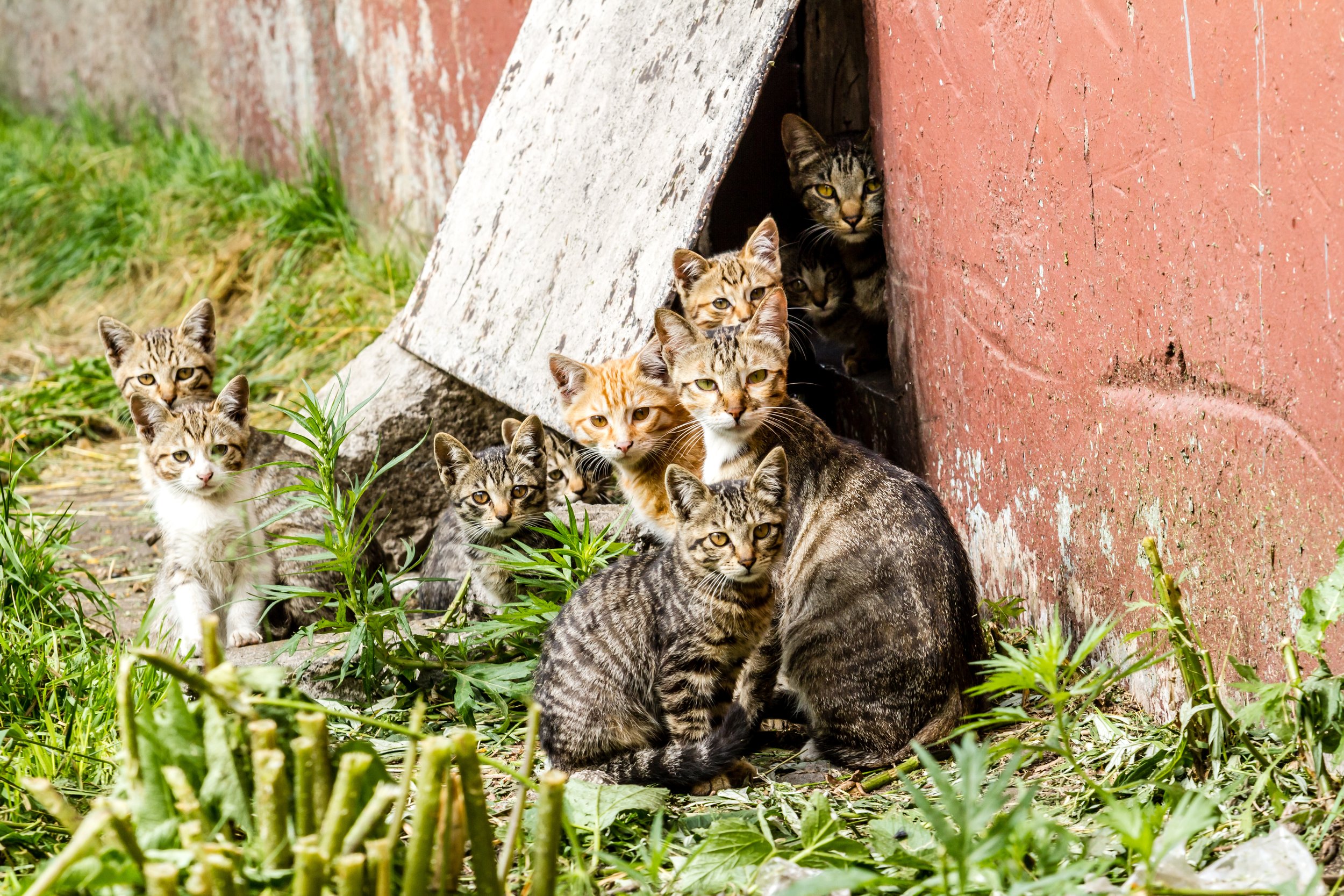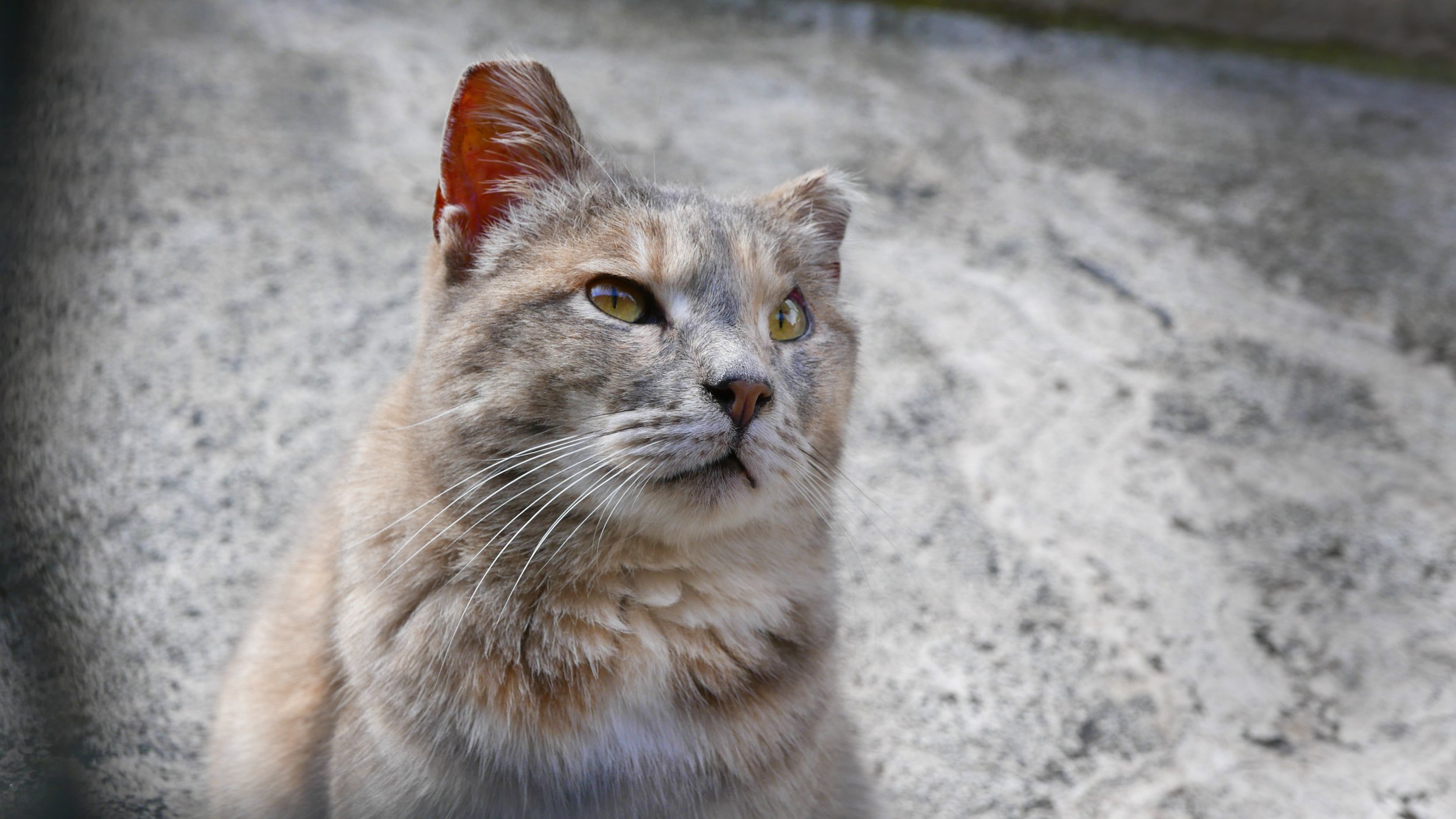
Community Cats
Caring For Our Outdoor Feline Friends
What Are Community Cats?
Community cats, also known as feral, stray, or free-roaming cats, are unowned cats that live outdoors in neighborhoods, parks, and other outdoor spaces. These cats are typically not socialized to humans and rely on their instincts to survive. Community cats are not abandoned pets - they are cats that were born and raised outside. Abandoning pet cats is both inhumane and illegal.
Some people view community cats as pests, leading to harmful actions like neglect, mistreatment, or even killing. These practices are not only cruel and inhumane but also ineffective. Community cats usually congregate where they have access to food, so not putting out food and removing their access to trash is the best way to encourage them to move on. Otherwise, removing or harming community cats creates a vacuum effect, where new cats move into the area, leading to continued population growth and conflicts.
Humane methods like Trap-Neuter-Return (TNR) offer an even better solution for community cats:
TNR stabilizes cat populations by preventing new litters.
Vaccinated and sterilized cats are healthier and less likely to display nuisance behaviors or present a public danger.
Trap-Neuter-Return
Trap-Neuter-Return (TNR) is a humane and effective method of managing and reducing community cat populations. In a TNR program, community cats are humanely trapped, spayed or neutered, vaccinated, eartipped, and then returned to their outdoor homes. This process prevents future litters and improves the cats' health and quality of life while reducing unwanted behaviors like spraying and fighting.
TNR has been used for decades. Multiple studies show that it is an effective way to control community cat populations, improve their health, and protect public health.
Most TNR programs require completion of an educational program for participation. You will learn how to manage a colony of community cats, humanely trap cats, take them in for spay/neuter and vaccinations, and safely return them to their colony.
We do not currently have a TNR program. To participate in TNR in Detroit, please contact All About Animals or Michigan Humane.
-
What is Spay/Neuter?
Spay and neuter are surgical procedures that prevent the cats from reproducing.
Spaying is the removal of a female animal’s ovaries and uterus.
Neutering refers to the removal of a male animal’s testes.
Spay/neuter also improves the cats' health by lowering the risk of certain cancers and infections., and reduces unwanted behaviors like marking, roaming, and fighting.
-
Vaccinations prevent the spread of diseases that are dangerous to cats and people. Rabies vaccines are especially important for public health. The FVRCP vaccine protects cats from feline viral rhinotracheitis (feline herpes), feline calicivirus, and feline panleukopenia (feline distemper), which risk health and can easily spread to pet cats.
-
Eartipping is the universal symbol used to identify a community cat that has been spayed or neutered. During the spay or neuter surgery, a small portion of the cat's left ear is painlessly removed. This procedure is quick, safe, and performed under anesthesia.
Why is Eartipping Necessary?
Identification: It helps caregivers, animal control, and TNR teams instantly recognize that a cat has already been sterilized, preventing unnecessary trapping or duplicate surgeries.
Efficiency: Eartipping streamlines TNR efforts, saving time and resources.
Humane Management: It ensures that cats can continue to live safely in their community without disturbance.
-
Pregnant Cats: Pregnant cats can and should be spayed to prevent the birth of more kittens that may struggle to find homes. Spaying during pregnancy also helps reduce the risk of future health complications for the cat.
Nursing Cats: Nursing mother cats can be spayed once their kittens are at least three weeks old. After spaying, the mother can continue nursing her kittens. Since cats can become pregnant again while nursing, it’s vital to spay them as soon as possible when the kittens are old enough.
Cats in Heat: Cats in heat can and should be spayed. Spaying during this time helps prevent future litters and eliminates the behaviors associated with being in heat.
-
Kittens can be spayed/neutered once they are 12 weeks old. At this age, they can also be vaccinated for rabies.
Feeding Community Cats
Feeding community cats is a kind and compassionate thing to do, but it’s important to pair it with TNR. It is also a necessary first step for TNR. Be sure to feed the community cats consistently. Set food out twice per day at the same time and location. Pick up the food after feeding for an hour. Avoid feeding in the dark, which attracts wildlife.
Shelters for Community Cats
Shelters are a simple, lifesaving way to protect community cats from harsh weather and provide them with a safe place to rest. These shelters help cats stay warm in the winter, cool in the summer, and shielded from rain or predators.
Tips for Building or Placing Cat Shelters:
Use weather-resistant materials like plastic storage bins or insulated wood.
Ensure the shelter is elevated to avoid flooding and has a small entrance to keep out larger animals.
Add straw (not hay or blankets) for bedding, as it resists moisture and provides warmth.
Place shelters in a quiet, hidden area away from prevailing winds where cats feel secure.
By providing shelters, you can make a big difference in the health and safety of community cats.
Found Kittens
Discovering a litter of kittens outdoors can be heart-wrenching, and it’s natural to want to help. However, scooping them up or taking them to a shelter immediately might not be the best course of action. Kittens have the best chance of survival with their mother. To give kittens the best chance of survival, follow these guidelines.
When in doubt, reach out to your local animal control or cat rescue for expert guidance.
-
If the kittens are in immediate danger due to their location, gently move them to a safer spot nearby where mom can still find them.
-
Leave the kittens where they are and check if their mom is still around. Watch from a distance every couple of hours for 8–12 hours. Content, quiet kittens usually mean mom is returning to care for them. Sprinkle flour around their location and look for mom’s pawprints to confirm her visits.
-
If you see the mother cat, leave the kittens alone. She is their best chance at survival.
-
If the kittens appear dirty, underweight, sick, or dehydrated, contact your local animal control or rescue organization. They can assess whether intervention is needed.
-
If you confirm mom isn’t returning, keeping the kittens warm is critical. Kittens less than 3 weeks old can become dangerously chilled very quickly. Kittens less than 3 weeks old can’t stand and their eyes and ears are not fully open. Signs of chilling include being listless or cool to the touch. Use your body heat or a warm cloth to gently warm them up and stimulate circulation.
⚠️ Important: Never attempt to feed a cold kitten. Kittens must be fully warmed up before feeding.
Managing Kittens
Community kittens can be socialized for adoption, or allowed to remain in their colony. Whether adopting out or returning to the colony, you’re making a difference in their lives and helping to manage the community cat population responsibly. Here's what you need to know:
-
Kittens can become loving pets, but they need to be socialized to feel comfortable around people.
Under 8 Weeks Old: Most kittens this age can be socialized easily by anyone with patience and care.
8 Weeks to 4 Months Old: Older kittens may take more time and skill to socialize, as they might be wary of humans. Socializing kittens requires a significant commitment but can lead to a rewarding outcome for both you and the kittens.
-
If kittens remain in their colony, it’s essential to trap them when they’re about 12 weeks old. They should be spayed or neutered, vaccinated, and then returned to their colony to live out their lives healthily and without contributing to overpopulation.
Getting Along with Neighbors when Managing a Cat Colony
Managing a cat colony can sometimes create concerns among neighbors, especially if cats are venturing into their yards, gardens, or other spaces. To maintain good relationships, it’s important to respect your neighbors’ concerns and work with them to find solutions. Open communication and proactive efforts can help resolve issues peacefully. By working together and using these solutions, you can help maintain harmony with your neighbors while caring for your cat colony responsibly.
-
Start a Conversation: Talk to your neighbor to understand their concerns. Determine if the cats are pets or strays and ensure they are spayed or neutered to reduce unwanted behaviors.
Respect Their Opinions: Listen empathetically and offer to implement solutions to minimize the cats’ impact on their property.
-
1. Cats Digging in Gardens
Use deterrents like fresh orange or lemon peels, coffee grounds, citrus sprays, lavender oil, or cayenne pepper.
Install physical barriers like chicken wire, plastic sheets, or carpet runners bumpy side up, covered lightly with soil.
2. Cats Sleeping Under Porches or in Sheds
Apply natural repellents around these areas.
Install barriers like chicken wire or lattice to block access (after checking for kittens!).
Provide alternative shelters like a plastic bin or doghouse in a secluded spot.
3. Cats Raiding Trashcans
Secure trash bags inside tightly lidded cans.
Feed the cats yourself to ensure they’re not scavenging for food.
4. Paw Prints on Cars
Relocate feeding stations and shelters away from driveways and parking areas.
5. Fighting, Yowling, Spraying, and Roaming
These mating behaviors stop once cats are spayed or neutered.
For urine odors, use white vinegar or enzyme-based cleaners like Nature’s Miracle.
6. Attracting Wildlife
Only feed cats during the day and pick up excess food to avoid attracting raccoons or other animals.
Planning Back-Up Care for Your Cat Colony
Life can bring unexpected challenges, such as illness or travel, that may temporarily prevent you from caring for your community cat colony. Planning ahead by finding a substitute caretaker is crucial to ensuring your cats are cared for in your absence.
While no one may care for your cats exactly as you do, having a trusted back-up caretaker ensures their well-being during your absence. A solid plan gives you peace of mind and guarantees the cats continue to receive the love and attention they need.
-
Reach out to neighbors, friends, family, or others who are familiar with your colony.
Connect with local cat caregivers who may be willing to step in temporarily.
-
Provide a photo of each cat and their medical history.
Share your feeding schedule, care routine, and any special instructions.
-
Stock up on food, medicine, and other necessities.
Decide whether expenses (e.g., vet visits) will be covered by you or the substitute caretaker.
-
Relocating cats should be a last resort and only considered in extreme situations where their lives are in danger. Relocation is stressful for cats and often unsuccessful.
Relocating Community Cats
Relocation involves moving cats from their current outdoor home to a new location. While it may seem like a solution in certain situations, it is a labor-intensive process with a low success rate. Community cats are deeply attached to their territory, caretaker, and fellow colony members. Relocating them can cause stress, fear, and disorientation, disrupting their established bonds and routine.
Relocation should always be a last resort. If relocation is absolutely necessary, you can help ensure their best chance of adjusting to a new environment by following these guidelines.
-
Relocation should only be considered in specific circumstances:
The cats face immediate, unresolvable threats to their lives.
The property owner or manager prohibits maintaining the colony.
The colony’s shelter is being destroyed, and no alternative in the vicinity is possible.
No caretaker is available to support the colony.
-
Cats are highly territorial, and staying in their established habitat is usually best for their health and safety. Relocation often results in cats disappearing, being harmed, or attempting to return to their original territory.
-
Relocation has the lowest success rate in these situations:
Very feral cats being moved.
Relocating too few cats from the same colony.
Relocating solitary cats or kittens under six months old without their mother.
-
If relocation is unavoidable, follow these steps to improve the chance of success:
Select a Safe Site: Ensure the new location is secure, permanent, and supported by a committed caretaker.
Prepare a Confinement Area: Use a clean, secure, and quiet space with proper ventilation and light. Include a wire crate, litter pan, food and water bowls, and a hiding carrier.
Acclimate the Cats: Confine cats in the crate for at least two weeks, allowing them to adapt to the new environment. Feed them regularly and interact gently to build trust.
-
Relocate cats in pairs or groups for comfort.
Keep the crate covered to reduce stress.
Maintain a consistent feeding schedule and bond with the cats through verbal communication.
If a cat escapes during confinement, leave food and water nearby and sprinkle used litter to attract them back.
After release, continue feeding in the same area to establish the new territory.
Learn More About Community Cat Care
Want to learn even more about community cats and their care? Click here to access Alley Cat Allies’ extensive resources.





